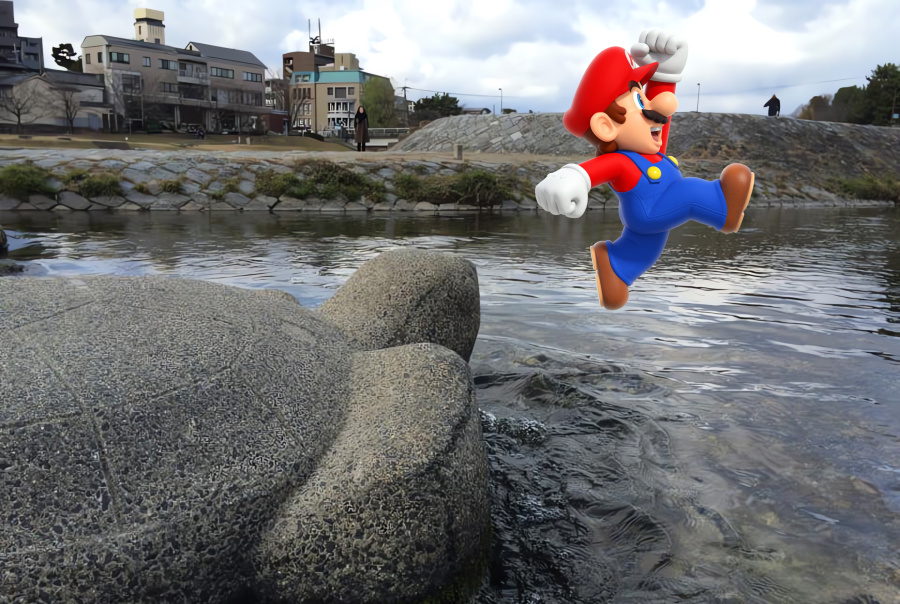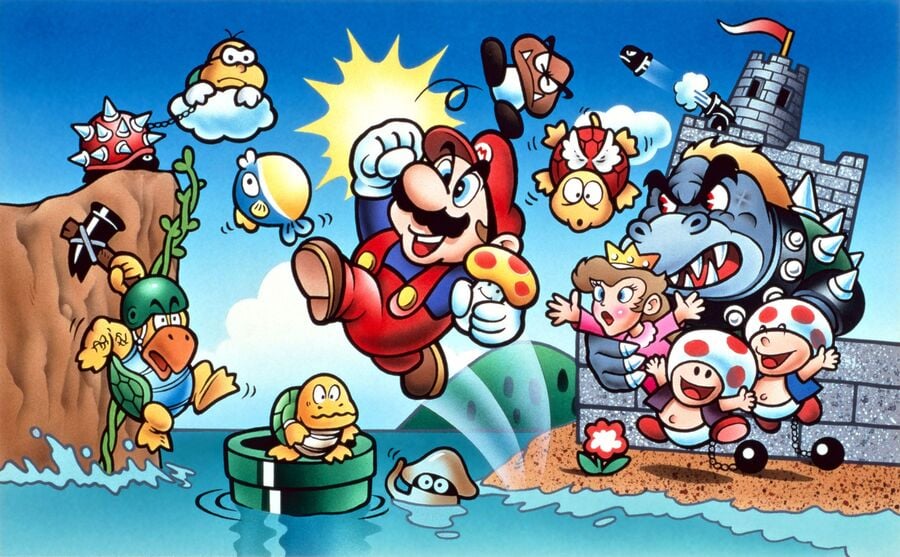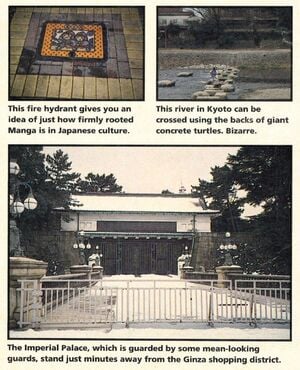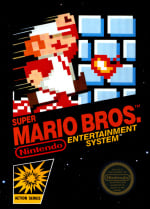
The phrase "Egg of Columbus" is used to describe a brilliant discovery which seems so obvious after the fact. It's something we've been pondering for weeks now, ever since interviewing former games journalist Frank O'Connor for our recent 'Nintendo's Golden Ticket' feature.
"I might conflate my discovery of turtle stepping stones across Kyoto's canals – which has a very obvious implication for the Mario universe! – and walks I took with [prize winner] Gareth," O'Connor said during our chat.
Wait a minute... in the city of Kyoto, the birthplace of Nintendo and Mario, there are canal crossings where people can jump on the backs of turtles? It was a throwaway anecdote in a long interview, but the statement caught our attention.
We asked O'Connor to elaborate, and he was happy to do so. "On the first day in Kyoto, after unpacking and getting my bearings, I walked along the river near the hotel and found a line of huge stepping stones, carved and decorated, for pedestrians to cross the shallow water. Think LA drainage canals, but beautifully tended, decorated, and integrated into the city as both trail and park. Lo and behold: many were turtles. Of course, being an intrepid journalist, I had to cross them, and it clicked: This is Super Mario Bros.! I'm jumping on turtles to cross a hazard, while fish swim oblivious below."

Was there a connection? In any other city on Earth, maybe not – the concept of stepping stones is millennia old, turtles love water, it seems too obvious after the fact... but in Nintendo's own backyard? The possibility resonated strongly with us. The turtle stones resonated strongly with O'Connor, too, given that Mario had been a formative experience in his youth.
"The first time I played Super Mario Bros., was as a teen in an arcade in Scotland – basically just NES consoles with coin slots," he recalls. "It was the first game where I had my mind blown by Miyamoto using our assumptions to surprise and delight – the ability to jump over the high score text and into hidden spaces genuinely affected me, my first insight into games being their own, self-contained, and fundamentally important art form. That connection to this real-world turtle discovery and Miyamoto's acknowledgement had a value that stays with me to this day. Miyamoto was my North Star for video games."
O'Connor naturally interviewed Miyamoto for the Japan competition trip, so this second revelation of Miyamoto's acknowledgement of the turtles caught our interest again. Case closed, surely?
"By the time I met Mr Miyamoto, I had prepared, trashed, and re-prepared questions a zillion times," O'Connor recalls. "This was a once-in-a-lifetime opportunity, and I didn't want to waste questions, not knowing how the interview and meeting would play out. As a journalist, the temptation is to ignore old ground and seek new answers but, with Miyamoto in particular at that time, the 'Wonka' comparison was strong, and it was hard to find sourcing of quotes or ideas attributed to him."

This raises an important point that, in hindsight, is easy to take for granted. At the time of O'Connor's visit and interview, in February 1994, the world wide web was only around three years old – and it only became an 'open' system in 1994. There were very few websites – fewer, if any, dedicated to games – and there was no such thing as social media, no YouTube, and no Google Translate to convert Japanese text into English. (In fact, Google didn't even exist yet, and something as old as GameFAQs was still over a year away.) In many ways, Japan and Nintendo were still closed books, with very little first-hand information available to the public. Magazines were the dominant media of the day, and O'Connor would have had to research this the old-fashioned way.
"I had read a few bits from Famitsu, Login, and other Japanese magazines of the era," explains O'Connor, "where Mr Miyamoto famously talked about caves and temples and forests near Kyoto, but the city is kind of magical in the sense that it's actually a very bland metropolis compared to Tokyo, but is both bounded by and encapsulates dozens of little pockets of gorgeous woodland, rocky hillsides, temple gardens, plus strange, ancient and runic feeling shrines and spiritual environments. I definitely 'got' Zelda vibes from simply walking around and exploring, but that's likely a bit of confirmation bias."
The best resource at the time would have been the seminal Game Over by David Sheff. If you check out the unabridged version, you'll find plenty of corroborating descriptions. On pages 44 and 45, Sheff describes Miyamoto's childhood, exploring the countryside, and so on; how on one occasion, Miyamoto found a cave and, using a homemade lantern, returned to explore it – plus a river that divided the city. On pages 50 through 52, he describes the influences of Mario, the idea of flying turtles, discovering a lake while exploring, a city manhole that to Mario would be like exploring a cavern, plus paper-door mazes, monstrous fish, and more.

It's a beautiful series of chapters describing the boyhood discoveries which would later influence Shigeru Miyamoto when creating Mario and Zelda. A meticulous search of Game Over, however, does not reveal anything about turtle stepping stones across a river.
We had to know, did O'Connor broach this subject with Miyamoto? Did he ask about the turtles? He'd seen them on his first day in Kyoto, surely this discovery had to be raised?
"I asked about this and the other environmental inspirations through his translator. Mr Miyamoto smiled and said 'Yes!' - seems trivial 30 years later but, at the time, it felt like a cute story nugget, and also a personal Rubicon, if you'll forgive the double-river analogy. I [wrote] about it, but it wasn't clear from the translator's response if it was 1:1 inspiration, though he did seem to acknowledge it – hard to recall, and I definitely no longer have those notes. I know he once mentioned something similar with regards to local caves and temples. And, of course, it's possible it was life imitating art – though both the design and context made me think they were older and unrelated to Super Mario Bros."

The coverage in O'Connor's magazine Total! did indeed have a photo of the turtle stepping stones and caption, and there was an interview with Miyamoto, but his detailed answer on Mario didn't mention the stones. Sadly Miyamoto's unpublished response to the stones question was so vague, without O'Connor's notes and an audio recording to dissect, it's difficult to know how to interpret. He could have meant any of the following:
- "Yes, I saw those stones as a child and would jump across them."
- "Yes, those stones were installed as a homage to Nintendo's Mario character."
- "Yes, I know of those stones, they're a cultural landmark of Kyoto."
This is all becoming speculation, though, reflected through the rose-tinted lenses of 30-year-old glories. If they do predate Mario, then they may have been an influence. If they came after the fact, then maybe Mario influenced them? We needed hard facts, so we emailed the Kyoto City Tourism Association. We did not mention Nintendo or Mario, since we did not want to taint any response. We simply asked when they were installed and why.
The Kyoto City Tourism Association replied: "Thank you for your interest in the 'turtle stepping stones' of the Kamo River (Kamogawa). According to the Japanese newspaper 'Asahi Shimbun', it was built around 1992. It is not that old. They seem to be made of concrete, not cement. It seems the Kyoto Prefectural Public Works Department, which manages the Kamo River, installed the stones to protect the river bottom from being cut by the current and to create a place where people can play in the river. We hope this will be of some help to you."
A little digging online in Japanese also brought up Tabi-Mag, which stated: "Concrete blocks are placed on top of the shingles (traversing structures that prevent the river bottom from being eroded) to stabilize the riverbed. During the river environment improvement, we adopted design blocks such as plovers, boats, turtles, and triangular rice balls, based on the ideas of Kyoto civil engineering office staff. The stepping stones were locally manufactured by Keihan Cement Industry."
More significantly also Nikkei.com, which gave a date and name of the creator: "In 1993, stepping stones were placed along the Kamo River delta. A total of 83 stones were made, including not only rectangular but also turtle shaped. The person who came up with the idea was Shigenori Yoshimi, 62, who was a technical staff member at the Kyoto Civil Engineering Office at the time."

Although there's a discrepancy in dates between the Asahi Shimbun and Nikkei, it doesn't really matter. Both 1992 and 1993 firmly place the installation long after Mario's conception. As noted, there are also other styles of stone besides turtles. Had Shigenori Yoshimi been a keen Famicom player in his spare time?
In our research, we asked several Japan-based game developers – mainly to secure some photos. Wonder Boy creator Ryuichi Nishizawa and Silent Scope creator Masaaki Kukino both replied with photos and permission to reprint them. Neither gentleman commented on our speculation of connections to Mario. We even contacted a former Nintendo employee, who didn't want to be named, though they thought it unlikely there was any connection.
Without asking Shigenori Yoshimi directly, we may never know. But whatever the origin of the stones, they are a picturesque sight in Kyoto and, as shown, can truly spark the imagination. Have you ever come across something in real life that made you pause because it seemed lifted straight out of your favourite video game? Post in the comments and let us know.






